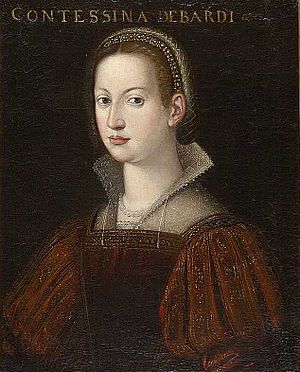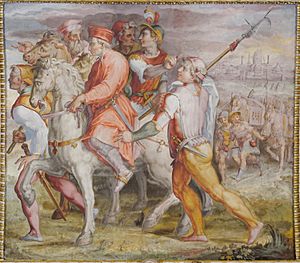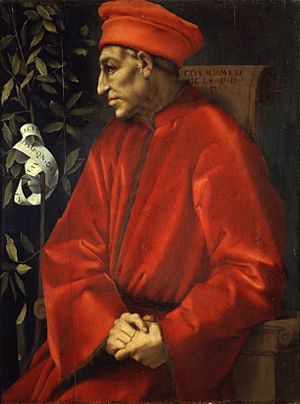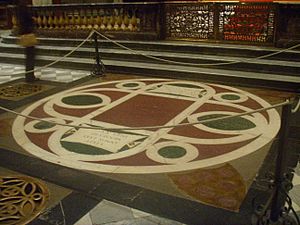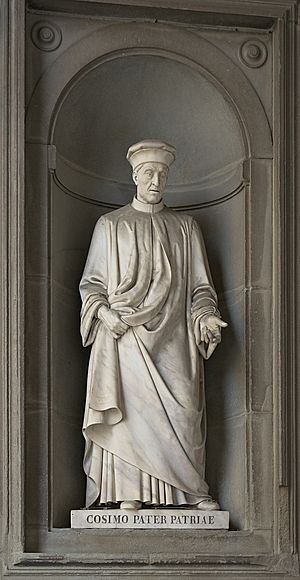Cosimo de' Medici facts for kids
Quick facts for kids
Cosimo di Giovanni de' Medici
|
|
|---|---|
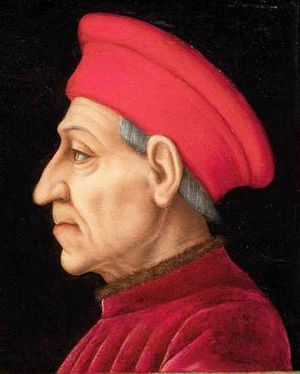
Posthumous portrait by Bronzino
|
|
| Lord of Florence | |
| Reign | 6 October 1434 – 1 August 1464 |
| Successor | Piero the Gouty |
| Full name |
Cosimo di Giovanni de' Medici
|
| Born | 27 September 1389 Florence, Republic of Florence |
| Died | 1 August 1464 (aged 75) Careggi, Republic of Florence |
| Noble family | Medici |
| Spouse(s) | Contessina de' Bardi |
| Issue | Piero the Gouty Giovanni de' Medici Carlo di Cosimo de' Medici (illegitimate) |
| Father | Giovanni di Bicci de' Medici |
| Mother | Piccarda Bueri |
Cosimo di Giovanni de' Medici (born September 27, 1389 – died August 1, 1464) was an important Italian banker and politician. He helped the Medici family become the real rulers of Florence during much of the Italian Renaissance.
Cosimo's power came from his huge wealth as a banker. He also made sure his family married into other powerful and rich families. He was a big supporter of arts, learning, and architecture. He spent a lot of money on art and culture, including Donatello's famous David statue. Even with all his influence, his power was not absolute. Florence's government councils sometimes disagreed with his ideas. People saw him as the most important among equals, not a dictator.
Contents
Cosimo's Life and Family Business
Early Life and Family
Cosimo de' Medici was born in Florence on September 27, 1389. His parents were Giovanni di Bicci de' Medici and Piccarda Bueri. It was common then to add the father's name to a child's name. So, Cosimo was known as Cosimo di Giovanni de' Medici. He had a twin brother, Damiano, who died very young. Cosimo also had a younger brother, Lorenzo, known as "Lorenzo the Elder". Lorenzo helped with the family's banking business.
Cosimo learned about banking and inherited his wealth from his father, Giovanni. Giovanni had started his own bank, the Medici Bank, in Florence in 1397.
The Medici Bank grew quickly. It opened branches in cities like Rome, Geneva, and Venice. Most of the bank's money came from its Rome branch, which handled the Church's finances. Cosimo later expanded the bank even more, opening offices across western Europe. This made the Medici Bank the best choice for the Pope's business. It allowed churches across Europe to pay their fees easily. It also helped the popes order goods like spices and textiles.
In 1415, Cosimo was with Antipope John XXIII at the Council of Constance. Earlier, Giovanni had lent John XXIII money to become a cardinal. When John XXIII became Pope, he made the Medici Bank in charge of all papal finances. This gave the Medici family a lot of power. For example, they could threaten people who owed them money with excommunication (being kicked out of the church).
However, in 1415, the Council of Constance removed John XXIII from power. This meant the Medici Bank lost its special control over the Church's money. But after another bank failed in 1420, the Medici Bank became important again. John XXIII was held captive, but the Medici family paid his ransom and gave him a safe place to stay.
In 1415, Cosimo was also named "Priore of the Republic [of Florence]". He often worked as an ambassador for Florence. He became known for his careful and wise decisions.
Around 1415, Cosimo married Contessina de' Bardi. Her family, the Bardi, had been very rich bankers. This marriage helped strengthen ties with an old noble family. Cosimo and Contessina had two sons: Piero the Gouty (born 1416) and Giovanni de' Medici (born 1421). Cosimo also had a son named Carlo, born outside of marriage, who became a church leader.
In 1420, Giovanni stepped back from the bank. He left its leadership to Cosimo and his brother. When Giovanni died in 1429, he left them a large fortune. Besides the bank, the family owned a lot of land around Florence.
Cosimo's Role in Florentine Politics
Cosimo's power in Florence came from his wealth. He used his money to influence votes in the city's government councils. The most important was the Signoria of Florence. Florence was proud of its "democracy". So, Cosimo pretended not to be very interested in politics. He did not often hold public office himself.
By 1433, some people in Florence saw Cosimo's power as a threat. These were people like Palla Strozzi and the Albizzi family. In September of that year, Cosimo was put in prison in the Palazzo Vecchio. This was because of a failed attempt to conquer the city of Lucca. But he managed to change his prison sentence into exile. Some important Florentines wanted him executed. But a monk named Ambrogio Traversari helped him.
Cosimo went to Padua and then to Venice. He took his bank with him. He found friends and supporters everywhere he went. People admired him for choosing exile instead of starting bloody fights in Florence. Venice even sent a message to Florence asking them to cancel his banishment. When Florence refused, Cosimo settled in Venice with his brother. Many people followed him, including the architect Michelozzo. Cosimo asked Michelozzo to design a library as a gift to Venice.
Within a year, so much money left Florence that the city had to lift the exile order. Cosimo returned in 1434. He continued to influence the government of Florence for the next 30 years.
His time in exile made Cosimo realize he needed to stop the fighting between different groups. To do this, he made changes to the government. He worked with friendly officials in the Signoria to make his power stronger through influence.
After the ruler of Milan, Filippo Maria Visconti, died in 1447, Cosimo sent Francesco I Sforza to take control of Milan. This was to stop the Venice from attacking. Francesco Sforza was a condottiere, a mercenary soldier. He had married Visconti's daughter. This created a balance of power in Italy. Florence and Milan were on one side, and Venice and the Kingdom of Naples were on the other. This led to almost 50 years of peace. This peace helped the Renaissance grow in Italy.
In terms of foreign policy, Cosimo worked for peace in northern Italy. He wanted a balance of power between Florence, Naples, Venice, and Milan. He also tried to stop outside powers like France and the Holy Roman Empire from getting involved in Italian affairs. In 1439, he helped convince Pope Eugene IV to move an important church meeting, the Ecumenical Council of Ferrara, to Florence. Many important people from the Eastern Roman Empire came to this event. This helped spark more interest in ancient Greek arts and literature.
Cosimo's Death
Cosimo died in 1464 at Careggi. His son Piero took over after him. Piero was the father of Lorenzo the Magnificent. After Cosimo's death, the Signoria gave him the title Pater Patriae, which means "Father of the Fatherland". This honor was carved on his tomb in the Church of San Lorenzo.
Cosimo's Support for Arts and Learning
Cosimo de' Medici used his personal fortune to control Florence's government. He also used it to support speakers, poets, and thinkers. He funded many amazing artistic projects.
Arts
Cosimo was famous for supporting culture and the arts during the Renaissance. He spent his family's money freely to improve life in Florence. He once said that spending money gave him more pleasure than earning it. He believed that supporting the arts was a way to honor God and be remembered. It also showed the responsibility that came with wealth.
Cosimo hired the young architect Michelozzo Michelozzi. Michelozzo designed the Palazzo Medici, a grand Florentine palace. This building still has the Magi Chapel inside, painted by Benozzo Gozzoli. The chapel shows members of the Medici family as the Three Wise Men. Cosimo also supported artists like Fra Angelico, Fra Filippo Lippi, and Donatello. Donatello's famous David and Judith Slaying Holofernes were ordered by the Medici family. Cosimo's support also helped the architect Brunelleschi finish the huge dome of Santa Maria del Fiore (the "Duomo") in 1436.
Libraries
In 1444, Cosimo de' Medici started the first public library in Florence. It was at San Marco and was very important for the humanist movement. Michelozzo designed it. Cosimo paid to fix the library and fill it with books. People could use these books for free. By funding this library, Cosimo became a leader in the city. He chose who could use this "learning laboratory." This way, he helped shape the politics of Florence. He also asked Michelozzo to design a library for his grandson, Lorenzo. Cosimo's first library was designed in Venice when he was in exile. He left it as a gift to the city. His libraries were known for their beautiful Renaissance style.
Cosimo grew up with only three books. But by age thirty, he had 70 books. He learned about humanism from scholars who asked for his help to save old books. He loved this movement and supported efforts to bring back Greek and Roman knowledge through literature. Collecting books was a big part of this. He even traveled to find books. He paid 45 copyists to write out manuscripts. He also paid off the debts of Niccolò de' Niccoli to get his collection of about 800 manuscripts. These manuscripts later became the start of the Laurentian Library, founded by Cosimo's grandson, Lorenzo de' Medici.
Philosophy
In philosophy, Cosimo was influenced by the ideas of Gemistus Plethon. He supported Marsilio Ficino and his efforts to bring back Neo-Platonism. Cosimo asked Ficino to translate all of Plato's works into Latin. This was the first complete translation ever. Cosimo also collected a huge library that he shared with thinkers like Niccolò de' Niccoli and Leonardo Bruni. He also started a Platonic Academy in Florence in 1445. He made sure his grandson Lorenzo de' Medici received an education in the studia humanitatis (humanities). Cosimo definitely influenced Renaissance intellectual life. But Lorenzo would later be seen as the greatest supporter of the arts and learning.
Cosimo in Stories and TV
- The TV miniseries The Age of the Medici (1973) is about Cosimo. It shows his political struggles and how he supported arts and sciences. Cosimo is played by Marcello Di Falco.
- The TV series Medici: Masters of Florence (2016) shows the Medici family's rise after Cosimo's father, Giovanni (played by Dustin Hoffman), dies. Cosimo (Richard Madden) takes over the family. The next season, Medici (2019–2020), follows Cosimo's grandson, Lorenzo the Magnificent.
See also
- History of Florence
- Villa Medici at Cafaggiolo
 In Spanish: Cosme de Médici para niños
In Spanish: Cosme de Médici para niños



